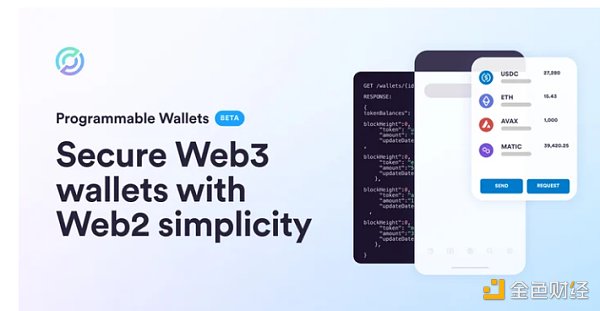Author: LianGuaiJason
Since the launch of the open-source digital dollar USDC in 2018, Circle has been committed to providing infrastructure to improve the user experience of blockchain. USDC is currently used on multiple networks. Earlier this year, Circle introduced the Cross-Chain Transfer Protocol (CCTP), which enables USDC to flow locally on the blockchain, unifying liquidity in Web3 and further enhancing the user experience.
Today, Circle announced the launch of a programmable Web3 wallet, the first product in its Web3 service product line, designed specifically for developers to embed secure encrypted wallets into any application.

Why is Circle launching a programmable wallet?
Currently, more than 4,000 companies are using USDC for their businesses. While wallets are not a universal service product, programmable wallets bridge the gap between the Internet and blockchain networks by abstracting complexities such as private key security, blockchain node operations, transaction management, and cross-blockchain interoperability. This allows developers to iterate applications faster. Furthermore, programmable wallets provide developers with the flexibility to choose the right security controls and customize wallet experiences based on their use cases, such as:
-
Funds management, transactions, and DeFi applications require users to control access and sign each transaction to maximize ownership.
-
Game developers may want wallets to initiate asset transfers without interrupting gameplay.
-
E-commerce companies can issue loyalty tokens without the additional steps of merchants and users signing each NFT transfer, and wallet infrastructure that allows configuring wallets for each use case can improve customer satisfaction while maintaining security and usability.
Programmable wallets aim to help developers customize wallets based on the best user experience for their applications. Developers can choose the best wallet security and control configurations according to their use cases. Some developers and companies may prefer hosted MPC nodes, while others may choose to quickly get started with Circle’s hosted MPC nodes. Developers can choose to share transaction signing responsibilities with users or ensure that each transaction is explicitly signed by users. Circle’s APIs and SDKs provide flexibility for developers to support the applications they are building.
Circle’s programmable wallet is an end-to-end self-service, allowing developers to quickly register, build, and deploy their first wallet and transactions within minutes. The developer console provides a one-stop platform with the necessary tools for debugging, launching, and scaling Web3 applications.
With USDC, CCTP, programmable wallets, and other Web3 service products, Circle aims to enable developers to easily and quickly build, deploy, and scale blockchain-driven applications for various use cases, regardless of the blockchain network they choose to build on.
Ten Sentences to Help You Understand Circle’s Programmable Wallet
1. User-controlled wallet: Allows end users to configure transactions and have complete control over their assets.
2. Developer-controlled wallet: Enables developers to manage asset configurations on behalf of users, resulting in a more familiar and simplified experience.
3. REST API: A powerful set of application interfaces for managing user-controlled and developer-controlled wallets, creating users and wallets, and managing transactions.
4. SDKs for iOS and Android to enable faster development and customization of the wallet UI.
5. Real-time status updates through webhooks for incoming or outgoing transactions, ensuring the latest user experience.
6. Wallet operation dashboard allows developers to monitor transactions, provide support in case of transaction failures, and reset security PINs when users are locked out.
7. All wallets are built with multi-party computation (MPC) encryption security, with infrastructure managed by Circle.
8. Blockchain agnostic: Built once, deployable on Avalanche, Ethereum, and Polygon blockchains, with support for more blockchain networks in the future.
9. Pay-as-you-go pricing, with discounts available when using USDC. Monthly active wallets start at $0.05, with more usage resulting in greater discounts.
10. Additional features: More functionalities will be launched in the coming months, such as Gas Abstraction and Smart Contract Wallet.
Summary
The Ethereum genesis block was created on July 30, 2015. Eight years later, Ethereum has become one of the most dominant blockchain networks in the market, with growing interest from developers, lower transaction fees, and faster settlement times. However, less than 0.5% of the global developer community is actively building crypto-enabled applications. While the blockchain community has made significant progress in expanding infrastructure, Circle’s Programmable Wallet can take further measures to simplify the development of blockchain-driven applications and accelerate adoption.
Some content in this article is compiled from the Circle official website.
Like what you're reading? Subscribe to our top stories.
We will continue to update Gambling Chain; if you have any questions or suggestions, please contact us!